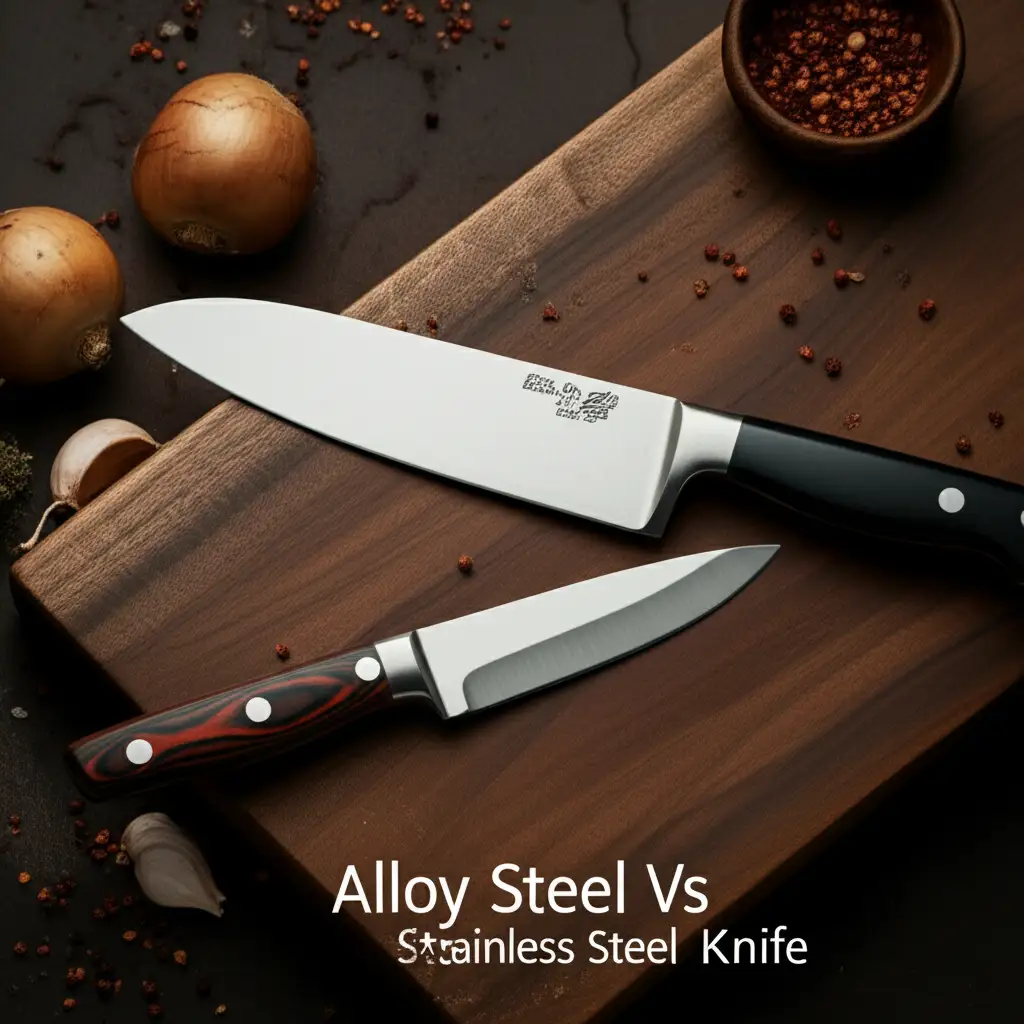· Liora Benning · Dining Etiquette · 17 min read
American Vs European Knife And Fork

American Vs European Knife and Fork: Mastering Dining Styles
Have you ever sat down for a meal and wondered if you are holding your fork correctly? Dining styles differ greatly across the globe. The way we use a knife and fork often reflects our cultural background. Understanding the differences between American and European knife and fork methods improves your dining confidence.
This article explores the distinct American and European dining practices. We will look at utensil handling, table manners, and the cultural reasons behind these differences. By the end, you will understand how to navigate various dining situations with grace. Let’s explore the world of utensil use.
Takeaway:
- The American style, known as the “zigzag method,” involves frequent hand switching.
- The European style, or “continental method,” keeps the fork in the left hand and the knife in the right.
- Each method has historical roots influencing its development.
- Understanding both styles helps you adapt to different dining environments.
- Practice improves your comfort and skill with each method.
The core difference between American and European knife and fork use lies in hand switching. Americans cut food with the knife in the right hand and fork in the left, then switch the fork to the right hand to eat. Europeans keep the fork in the left hand and the knife in the right throughout the meal.
Understanding the American Knife and Fork Style
The American knife and fork style is often called the “zigzag method.” This name comes from the way utensils move during a meal. People in America learn this method from a young age. It focuses on eating small, bite-sized pieces of food.
When you use the American style, you first cut your food. Hold the knife in your right hand and the fork in your left hand. Use the fork to hold the food steady. Cut a piece of food using the knife. After cutting, you put the knife down on the plate. Then, you switch the fork from your left hand to your right hand. You then eat the cut piece of food with the fork in your right hand. This back-and-forth motion explains the “zigzag” term.
This method allows for a pause between cutting and eating. It is seen as practical and efficient for many. Some people find it more comfortable to eat with their dominant hand. The American style of dining gives space for conversation during the meal. You pick up and put down utensils often. This makes it easy to gesture or talk between bites.
This style became common in America over time. Early American settlers often had less formal dining. They preferred a straightforward way to eat. The zigzag method provided this simplicity. It allows for a relaxed approach to meals. This contrasts with the more formal European methods. We often see it in casual family dinners and restaurant settings.
It is important to place your knife and fork correctly when paused. Place the knife across the top of the plate, with the blade facing you. The fork rests next to it. This signals you are taking a break but are not finished. When you finish eating, place the knife and fork together on the plate, angled at 4 o’clock. This tells your server you are done. The general idea is to pick up the knife, cut, put it down, switch the fork, and eat. This sequence repeats for each bite.
Exploring the European Knife and Fork Method
The European knife and fork method is known as the “continental style.” This style is common across Europe and many other parts of the world. It emphasizes keeping both utensils in hand throughout the meal. This method looks continuous and flowing.
To use the European style, you hold the knife in your right hand. You hold the fork in your left hand. The fork tines point down. You use the fork to secure the food. The knife cuts the food. After cutting, you do not switch hands. You simply lift the food with the fork in your left hand and bring it to your mouth. The knife remains in your right hand, ready for the next cut. This constant holding of both utensils gives the method its smooth appearance.
Many people find the European method more elegant. It avoids the back-and-forth movement of switching hands. This style shows a certain grace at the dining table. It allows for a quicker eating pace, as there are no pauses for utensil switching. This method is practical for cutting and eating at the same time. This is especially true for foods that require continuous cutting, like large pieces of meat. Understanding how to handle various knives, whether it is a small dining knife or understanding different knife sizes used for cooking, helps in mastering utensil control.
The European style often involves different ways to use the fork. The fork’s tines stay pointed down when you scoop food. This can be tricky at first. It requires practice to scoop peas or other small items. However, with practice, it becomes natural. The fork acts like a small shovel with the tines facing down. This creates a small cup.
When you pause during a European-style meal, you do not put your utensils down. Instead, you cross the knife and fork on your plate. The knife blade faces inward. The fork tines point down. This “rest position” signals that you are taking a break. When you finish eating, you place the knife and fork together on the plate. They are parallel, with the handles resting at the 5 o’clock position. This clear signal tells the server you are done. This shows good table manners.
Historical Roots of Dining Etiquette
Dining etiquette has a long and interesting history. The way we use forks and knives did not just appear overnight. These practices developed over centuries. Cultural norms and practical needs shaped them. Understanding this history helps us see why American and European styles differ.
Forks first gained popularity in Europe, especially in Italy, around the 11th century. They were not widely accepted at first. Many people found them unnecessary or even unholy. People often ate with their hands or used knives and spoons. The fork slowly became more common, particularly among the wealthy. By the 18th century, forks were standard in European dining. They were often used with a knife in the other hand. This laid the foundation for the continental style.
In Europe, table manners grew stricter over time. Dining became a more formal event. Holding both a knife and fork at all times showed refinement. It demonstrated skill and control. This continuous use of utensils became a sign of good upbringing. European dining also evolved with different types of knives for various purposes, from small dining knives to larger chef knives used for food preparation. For example, knowing about various types of chef knives shows the rich history of cutlery.
The American style developed somewhat differently. When Europeans migrated to America, they brought their dining habits. However, the new world was often more casual. There was less emphasis on strict formal etiquette. Pioneer life needed practicality. Eating with the fork in the dominant hand became a common habit. It was easier to cut and then switch for eating. This method became ingrained as the “American way.” It suited a less formal dining culture.
The industrial revolution also played a part. Mass-produced cutlery made knives and forks accessible to everyone. This widespread availability meant that dining habits could evolve more freely. The American zigzag method became a practical choice for many households. It simplified the process for everyday meals. These historical paths created two distinct but equally valid ways to enjoy a meal. Both methods reflect the values and history of their respective cultures.
Key Differences in Utensil Handling
The most striking differences between American and European knife and fork methods lie in how you hold and use the utensils. These differences affect everything from how you cut food to how you signal you are finished. Let’s break down the main points.
Holding the Knife and Fork:
- American Style:
- When cutting, hold the knife in your right hand. Your index finger rests on the top of the blade, near the handle. Hold the fork in your left hand. Your index finger points down to secure the food.
- After cutting, place the knife down. Switch the fork to your right hand. Hold the fork like a pencil or pen. Your index finger can point down the handle. This grip gives you control for scooping food.
- European Style:
- Hold the knife in your right hand. Your index finger rests on the top of the blade, near the handle. Hold the fork in your left hand. The tines of the fork point down. Your index finger can extend along the back of the fork.
- Both utensils remain in these hands throughout the meal. This means you do not switch the fork. This continuous hold creates a smooth flow of movement.
Cutting and Eating:
- American Style (Zigzag):
- You cut one or two pieces of food at a time.
- After cutting, you lay the knife down on the plate. Its blade faces inward.
- You then transfer the fork to your dominant hand (usually the right).
- You use the fork to spear or scoop the food and bring it to your mouth.
- This sequence repeats for each bite.
- European Style (Continental):
- You cut a piece of food.
- The fork remains in your left hand with tines down.
- You use the fork to lift the food directly to your mouth. There is no hand switch.
- This requires more dexterity with the left hand. It allows for a steady eating pace.
Signaling Pauses and Finishing:
- American Style:
- Pause: Place the knife across the top of your plate. The blade faces inward. Rest the fork on the plate next to it, tines up or down.
- Finished: Place the knife and fork together on your plate. They should be parallel, angled at the “4 o’clock” position (like hands on a clock). The blade of the knife faces inward.
- European Style:
- Pause: Cross the knife and fork on your plate. The knife goes over the fork, forming an “X.” The knife blade faces inward. The fork tines point down.
- Finished: Place the knife and fork together on your plate. They should be parallel, angled at the “5 o’clock” position. The fork tines point down.
These specific details matter in formal settings. Knowing them shows respect for dining customs. They also help avoid confusion for servers.
Cultural Meanings Behind Dining Practices
Dining practices are more than just ways to eat food. They reflect deeper cultural values and traditions. The differences in American and European knife and fork use show these varying cultural norms. Understanding these meanings adds richness to your dining experience.
In Europe, the continuous use of the knife and fork in the continental style often symbolizes efficiency and elegance. This method is seen as more refined and controlled. It suggests that you are focused on the meal and your company. The smooth, uninterrupted motions convey a sense of grace. This reflects a culture that values formality and precision at the table. In many European countries, good table manners are a key part of social upbringing. They show respect for food, the host, and other diners. The European method can also signal a practical approach to dining. You keep both tools ready for immediate use.
The American zigzag method, on the other hand, highlights practicality and a more relaxed approach to dining. Switching the fork to the dominant hand can feel more natural and comfortable for many. This reflects a culture that often values individual comfort and directness. The American style might seem less formal but is equally valid. It allows for more pauses, encouraging conversation. This reflects a more casual social interaction during meals. The emphasis shifts from continuous utensil handling to comfortable eating. This method is often associated with the frontier spirit, where strict rules gave way to practical solutions.
These cultural differences extend beyond just knife and fork usage. They influence general table manners. For instance, in America, it is common to cut a few bites at once. In Europe, people often cut only one bite at a time. This again links to the continuous flow versus the stop-and-go nature of each style. These subtle cues are part of a larger communication system at the dining table. Knowing these differences helps you fit in, whether you are dining in a quiet bistro in Paris or a bustling diner in New York. They are part of understanding the local social code.
Even types of knives and their specific uses reflect cultural differences. For example, a santoku knife applications are typically Japanese, focused on precision and versatility in the kitchen. While a dining knife is different, the underlying principle of using the right tool for the job remains. Different societies develop tools and techniques that best suit their needs and values. These dining customs are living traditions. They continue to evolve, but their roots remain firm in historical and cultural preferences.
When to Use Which Dining Style
Knowing both American and European knife and fork styles is a valuable skill. But when should you use each one? The answer depends on your location, the dining setting, and who you are dining with. Being adaptable shows respect and good manners.
When to Use the American (Zigzag) Style:
- In the United States and Canada: This is the standard method in these regions. Most people will use and expect this style.
- Casual Dining: Even in formal settings in America, the zigzag method is perfectly acceptable. It is very common in everyday home meals and casual restaurants.
- Personal Comfort: If you are dining alone or with close friends, use the style that feels most natural and comfortable for you. There is no need to overthink it in relaxed settings.
- Teaching Children: The zigzag method can be easier for children to learn. It simplifies the process by separating cutting from eating.
When to Use the European (Continental) Style:
- In Europe and Many Other Countries: This style is the norm across most of Europe, and in many parts of Asia, Africa, and South America. Using it shows respect for local customs.
- Formal Dining: If you are at a formal dinner, a business meal, or a diplomatic event, especially abroad, the continental style is usually preferred. It looks more polished and formal.
- Fine Dining Restaurants: Many high-end restaurants, even in the United States, have staff trained in European service. Using the continental style can align better with the atmosphere.
- Impressing Others: If you want to show your knowledge of etiquette and project a sophisticated image, practicing and using the continental style is beneficial.
- Continuous Eating: For foods that require frequent small cuts or scooping without putting utensils down, the continental style is very efficient.
My advice is to observe your dining companions. If you are in a new country, watch how others eat. This is often the best way to learn local customs. If everyone at a table uses the continental style, you can try to match them. It shows you are making an effort. If you are unsure, the continental style is often a safe bet in formal international settings. It is generally seen as acceptable worldwide. Remember, the goal is to eat comfortably and show good manners. The style you choose helps achieve this.
Mastering Both Styles for Global Dining
Becoming proficient in both American and European knife and fork styles makes you a more confident diner. It prepares you for any social or professional meal, anywhere in the world. Mastery does not mean abandoning one for the other. It means having the flexibility to choose the right method for the situation.
Tips for Mastering the American (Zigzag) Style:
- Practice the Cut: Focus on holding the knife securely in your dominant hand. Use the fork in your non-dominant hand to anchor the food. Cut a small, manageable piece.
- Smooth Transition: Practice putting the knife down. Then, move the fork to your dominant hand smoothly. Avoid awkward fumbling. Place the knife on the upper rim of your plate, blade facing you.
- Eat with Comfort: Use your dominant hand to bring the food to your mouth. This feels natural for many. Focus on taking small, polite bites.
- Signal Clearly: Remember the 4 o’clock position for finishing. This helps servers know you are done. It avoids confusion.
Tips for Mastering the European (Continental) Style:
- Consistent Grip: The key is keeping the knife in your right hand and the fork (tines down) in your left. This consistent grip needs practice.
- Effective Cutting: Use your knife to cut while the fork holds the food. Keep your elbows close to your body. Do not saw back and forth excessively.
- Fork as a Scoop: Practice using the fork with tines down. For items like peas, angle the fork slightly to scoop them. This takes coordination.
- Graceful Motion: Focus on smooth, continuous movements. Avoid jerky or sudden actions. The goal is an elegant flow.
- Proper Pauses: Use the “X” formation on your plate to signal a pause. This tells servers you are not finished yet.
- The 5 O’Clock Finish: Remember to place parallel utensils at the 5 o’clock position when you finish. This is the clear signal.
I found that practicing with different types of food helps. Try cutting meat, vegetables, and even tricky items like pasta. Watch videos of people using both styles. You can even try using a knife that is not a dining knife, like a small utility knife (if you were practicing general knife handling, not eating), to understand blade control. However, for dining, always use appropriate cutlery.
Building muscle memory is crucial. Start by practicing at home. Then, try it in less formal restaurant settings. Soon, both styles will feel natural. This adaptability is a great social asset. It allows you to feel comfortable and confident in diverse dining environments.
FAQ Section
What is the main difference between American and European dining?
The main difference is hand switching. American dining, or the zigzag method, involves switching the fork to the dominant hand after cutting food. European dining, or the continental method, keeps the fork in the left hand and the knife in the right hand throughout the meal. This creates a more continuous motion.
Why do Americans switch hands when eating?
Americans switch hands for comfort and practicality. Many people prefer to eat with their dominant hand. The zigzag method allows this by having diners cut with one hand and then switch the fork to the other hand for eating. This became a common practice due to less formal dining traditions in early America.
Is one knife and fork style better than the other?
No, neither style is inherently “better” than the other. Both American and European knife and fork methods are correct within their respective cultural contexts. The “best” style depends on the dining situation and location. Adaptability is key, showing respect for local customs.
Can I mix American and European styles?
While you can, it is generally best to stick to one style during a meal in a formal setting. Mixing styles might look inconsistent or unpolished. In casual settings, minor deviations are less important. However, understanding and choosing one method for the whole meal is good practice.
How do I signal I am finished eating in both styles?
In the American style, place your knife and fork parallel on your plate at the 4 o’clock position. The knife blade faces inward. In the European style, place them parallel on your plate at the 5 o’clock position. The fork tines point down. Both signals tell the server you are done.
Which style is more polite in formal settings?
In formal international settings, the European (continental) style is often considered more universally polite. It projects an image of elegance and continuous control. However, in formal settings within the United States, the American (zigzag) style is perfectly polite and customary. Always consider your location.
Conclusion
Understanding the differences between American and European knife and fork styles goes beyond simple table manners. It reflects a deeper appreciation for cultural nuances and historical developments in dining. The American “zigzag” method, with its practical hand switching, offers comfort and a relaxed approach. The European “continental” style, with its continuous utensil hold, provides elegance and efficiency. Both methods are correct and valid within their own cultural contexts.
By knowing both American vs European knife and fork techniques, you gain confidence in diverse dining situations. You can adapt your style to match local customs, showing respect and sophistication. Practice helps you feel comfortable with each approach. So, next time you sit down to eat, consider the cultural journey of your utensils. Choose the style that fits the moment. Now you can truly enjoy your meal with grace, no matter where you are in the world.





